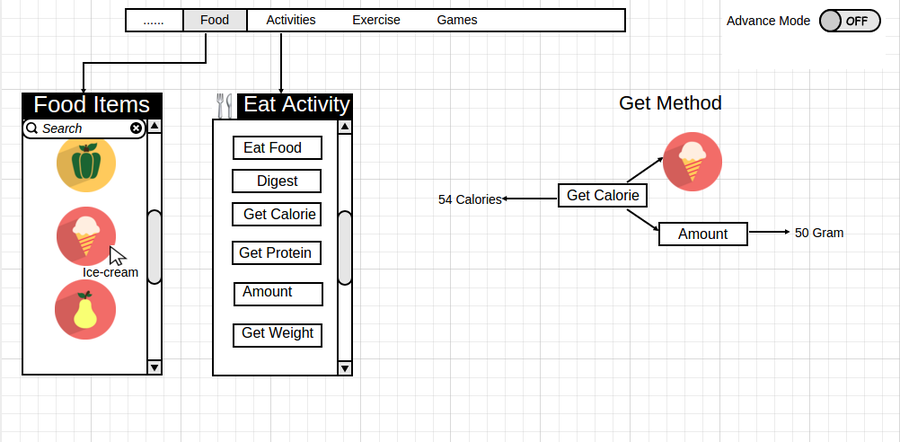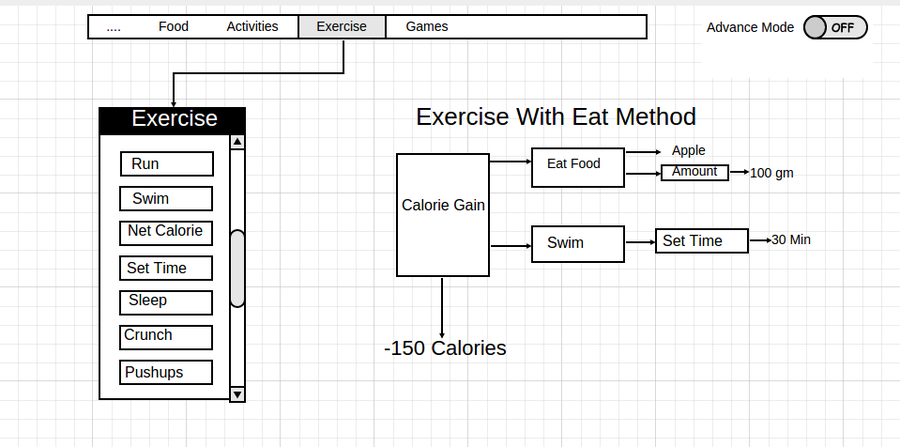Difference between revisions of "Summer of Code/2016/Nutritional Microworld"
| Line 75: | Line 75: | ||
'''ii) Exercise related activity :''' | '''ii) Exercise related activity :''' | ||
| + | |||
| + | This section would contains different types of exercises. User can use exercise activities in conjunction with food related activities to get better understanding of how nutrition is related to exercise. For instance, as can be seen from the diagram below, the calorie gain block would return the net calorie. For example, here it is used to find the net caloric gain after eating a piece of apple and swimming for 30 min. Since 100 gm of apple would give approximately 50 calories and swimming for 30 min causes approximately 200 calorie to burned. Thus, the net caloric gain would be -150 calories. | ||
| + | |||
| + | |||
| + | [[File:N2.png|border|center|900x600px]] | ||
Revision as of 00:45, 25 March 2016
About me
What is your name?
My name is Sneh Gupta, and I am a 3rd year undergraduate student at IIIT-Hyderabad.
What is your email address?
snehgupta42@gmail.com
What is your Sugar Labs wiki username?
Snehgupta
What is your IRC nickname on irc.freenode.net?
Sneh1234
What is your first language? (We have mentors who speak multiple languages and can match you with one of them if you'd prefer.)
My first language is Hindi, I am fluent in English.
Where are you located, and what hours (UTC) do you tend to work? (We also try to match mentors by general time zone if possible.)
Location: Hyderabad, Telangana, India
Time Zone: UTC + 5:30 (Indian Standard Time)
Working hours: (UTC + 5:30) 15:00 - 18:00 and 21:00 - 2:00
Have you participated in an open-source project before? If so, please send us URLs to your profile pages for those projects, or some other demonstration of the work that you have done in open-source. If not, why do you want to work on an open-source project this summer
I have been a part of sugar since January this year. This is my first time contributing to an open source organization, but so far I am really enjoying the experience. Ever since I started exploring the world of open source, I have been mesmerised by the simplicity and the noble intentions behind the work that is being done. Sugar labs in particular has grabbed my attention so far because of OLPC program. It is a great initiative, and I want to contribute in whatever way I can to it.
About my project
What is the name of your project?
Nutritional Microworld.
Describe your project in 10-20 sentences. What are you making? Who are you making it for, and why do they need it? What technologies (programming languages, etc.) will you be using?
The project Nutritional Microworld is for children to learn the fundamental concepts of nutrition. Children life nowadays is quite different that they tend to have an unhealthy lifestyle . By playing with nutrition microworld, children will be able to learn the concepts of nutrition in a fun and interactive manner.
This project is analogous to turtle-blocks. By utilising block programming children will be able to do a lot of new things.
I have made a basic UX design for each type of activity.
Nutrition Microworld can be a bit overwhelming for the beginners. So Nutrition microworld can be used in two different modes.
i) In Beginner mode user will have access to a limited set of functionality.
ii) In advanced mode extra functionality will be added to the beginner mode.
Beginner Mode -
On the basis of functionality we have three different types of activities :
i) Food related activity :
In this activity section user can select food items. The food items will contain images as well as nutrient information along with them. In this module, activities related to food items are present. For instance in the example below “Get calorie” method would take two arguments ice-cream and amount of it. Thereby returning the calories gained from it.
ii) Exercise related activity :
This section would contains different types of exercises. User can use exercise activities in conjunction with food related activities to get better understanding of how nutrition is related to exercise. For instance, as can be seen from the diagram below, the calorie gain block would return the net calorie. For example, here it is used to find the net caloric gain after eating a piece of apple and swimming for 30 min. Since 100 gm of apple would give approximately 50 calories and swimming for 30 min causes approximately 200 calorie to burned. Thus, the net caloric gain would be -150 calories.

